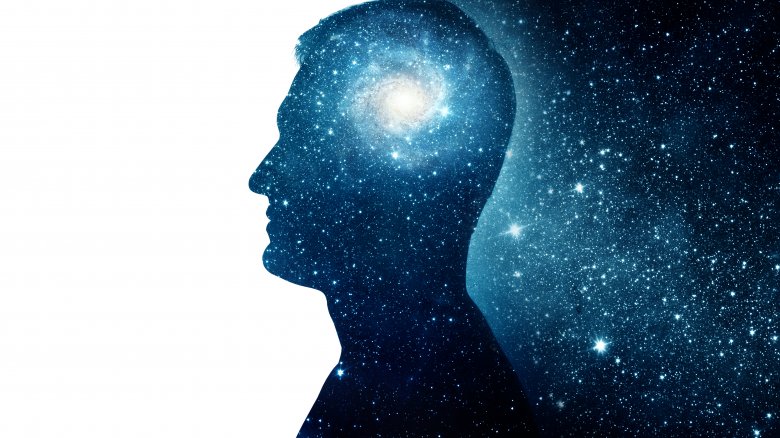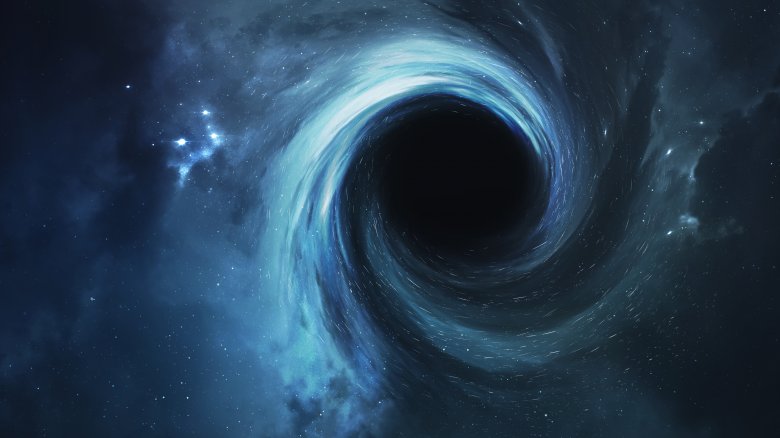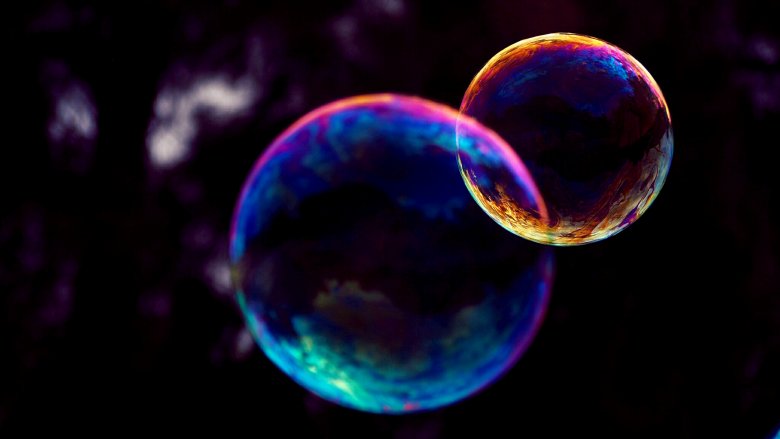The Most Complex Scientific Theories Explained For The Commoner
Not to be cynical, but one of the reasons our world is spiraling toward imminent doom and destruction (aside from the eventual likelihood of the heat death of the universe) is because science is hard. Politicians don't get it, so they pretend like it's not important. Regular folks have cable TV or Netflix or Facebook, so we stay in our bubbles. Now, that's not to say that any of the scientific theories described below would help politicians or citizens save the planet if only they could understand them — most of these theories only try to describe the universe, not save it. But if even the most complicated scientific theories can be broken down into chunks that are understandable to the average human, maybe we could all learn to understand the stuff that matters, too — you know, basic stuff like "a warming planet is kind of bad" and "immunology is for real" and "tan suits make people lose their freaking minds." Politicians probably won't actually try to understand any of those things, but a little wishful thinking never hurt anybody.
Schrodinger's rabid chicken
To get started, we just have to talk about Schrodinger's cat. This isn't really a scientific theory — it's a thought experiment, but it's an important baseline for understanding quantum mechanics. However, why on earth did it have to be a cat? Schrodinger couldn't have put something fundamentally distasteful in his box of death, like a cockroach or a rabid chicken?
Let's just say it was a rabid chicken. According to Minute Physics, you put the rabid chicken in a box with a device that has a 50/50 chance of killing the chicken or not killing the chicken. You wait for the device to do its thing and then you open the box, but in that moment just before you look inside, the chicken is neither alive nor dead but is in a state of being both alive and dead at the same time. It's only when the box is opened that nature decides which of the two realities is true.
What people sometimes fail to explain is that Schrodinger did not mean this to be taken literally. He was trying to demonstrate the absurdity of the quantum mechanics idea that a particle exists in all states until it's being observed, because obviously, the chicken can't be both alive and dead (in the universe that we understand). Schrodinger didn't really succeed, though, because scientists today pretty much accept quantum mechanics as a model for the subatomic universe. Also, chickens can't really get rabies. Welcome to quantum physics.
Particles behaving badly
Here's a fun puzzle that demonstrates what's called the observer effect. If you fire particles through two slits at a screen, some of the particles will go through one slit, and some will go through the other, leaving a double band pattern roughly corresponding to the slits. If you aim light waves at the two slits, you'll get an "interference pattern" on the screen, that is, repeating light and dark bands. This happens when waves interfere with one another as they pass through the slits.
If you do the same thing with electrons, which are tiny bits of matter, you get an interference pattern like the one left by light waves. But the particles don't pass through the slits in waves, though, so what gives?
According to physicist Jim Al-Khalili, scientists decided to send the electrons through the slits one at a time, to see if they might be bouncing off of each other. But they still got the same interference pattern, which suggests that some electrons went through both slits and then interfered with themselves in order to create that pattern on the other side.
So then scientists said, "Let's use a measuring device to see which slit each atom is going through." But when they did that, the electrons stopped creating the interference pattern and started producing the double band pattern you would have expected in the first place. This suggests that the act of being measured (observed) actually caused the electrons to change their behavior, much like naughty children. What exactly are you afraid of, particles?
There's at least one universe where everything goes your way
The really weird thing about the quantum world is that the smallest particles don't behave in the same way as things in the observable universe do. Subatomic particles seem to possess the ability to be in multiple states at the same time. Lightspeed Magazine compares this to a coin toss, like if it were possible for a coin toss to come up neither heads nor tails but both — only settling on one when the coin is actually being observed. So when the coin interacts with the world, only then does it collapse into the sort of reality that makes sense to us. One of the problems with this idea is that although we can predict how often a quantum particle might end up in one state or another, we don't know how that decision is actually made.
In the many worlds theory, the decision doesn't get made at all — instead, reality splits into two possible scenarios, both of which carry on oblivious to each other's existence. So in one scenario, the coin lands heads, in the other it lands tails, and meanwhile trillions of other worlds are also breaking off into infinite alternate worlds where collectively, everything that ever could have happened did. So that bad decision you made? You can find some comfort in knowing that an alternate version of yourself, somewhere, is reaping the rewards of not having made that same bad decision.
Particle romance
The quantum entanglement theory says that particles can influence each other even if they're separated by great distances, like billions of miles or maybe the entire length of the universe. According to ThoughtCo, when one of the two particles changes, some unseen force instantaneously causes the other particle to change regardless of the distance between them. Now, these aren't any old particles but are specifically particles that were created together and are therefore permanently linked to one another no matter where they may roam, which sounds almost romantic. The force that connects them? It would seem to be traveling way faster than anything should be able to travel, including light, but that's not what's happening. There isn't any actual movement through space — the two particles are entangled or intrinsically connected, so there doesn't have to be actual movement for the information to get from the first particle to the second one.
So you could say that the particles are kind of transcending time and space, like a very, very tiny TARDIS. And although it seems pretty crazy, scientists are actually attempting to use these ideas to develop computers capable of communicating over vast distances. Ultimately, we might be able to use entangled particles to instantaneously talk to explorers on the other side of the universe. Sure, we can't actually get explorers to the other side of the universe yet, but that's totally not the point.
Stringing the universe along
General relativity explains things we can observe, like stars and planets and the way gravity acts on them. Quantum mechanics explains the super-small quantum world. Until string theory, scientists were unable to reconcile the two ideas.
String theory attempts to find a common explanation for four forces of nature: electromagnetic force, strong and weak nuclear force, and gravity, each of which is produced by a corresponding carrier particle. But here's where it gets kind of convoluted. The problem is spacetime, which Space.com describes as the idea that space and time are a part of a single, curved continuum. In quantum field theory, particles can interact with each other at a single point of spacetime, or "zero distance." But under the theory of relativity, the graviton (basically the gravity particle that does the actions) can't operate at zero distance, so the two theories seemed incompatible.
Then along came string theory, which is the idea that subatomic particles are not points, but tiny, one-dimensional vibrating strings. The rate of each string's vibration determines what sort of subatomic particle it will become. String theory unifies general relativity and quantum mechanics because instead of points, strings are "smeared" or extended so they smooth the fabric of spacetime, which lets the graviton interact with quantum field particles. The theory does have some issues — it requires the existence of 11 dimensions, which is about seven dimensions beyond what we're familiar with. But at least that makes good fodder for science fiction writers.
Certain uncertainty
Physicists know a lot about quantum particles, but they don't know everything. That's because they can't actually know everything, at least not according to the Heisenberg uncertainty principle.
Now, as much as we would love to believe that the Heisenberg uncertainty principle has something to do with an RV parked suspiciously in the desert, it doesn't. According to The Guardian, the theory simply tells us there's a "fuzziness" to the laws of nature at the smallest scale. We can calculate probabilities for the behavior of particles at these scales, but that's the best we can do. That's because the closer you get to knowing a particle's position, the less certain you are about its momentum, and vice versa.
You can't simultaneously know both the position and momentum of a particle because a particle is fundamentally incapable of having both a precise position and a precise velocity. One major contributor to this problem is that quantum particles exist in a "cloud of probability," which basically means the particle doesn't exist in a single place at all, but in a state of probability — it has a small probability of being in this one place and a small probability of being in another place, and therefore can't ever really be nailed down as being exactly anywhere. So in other words, the only thing we can really be certain of is uncertainty, which sounds an awful lot like life as we know it anyway.
No-consequence time travel
Time travel is science fiction — we all wish we had a TARDIS, and we all know it's never going to happen. But time travel is not incompatible with what we know about physics. A wormhole could allow us to move through time, and string theory has a mechanism for that, too, but most of the existing theories of time travel, according to Phys.org, would require huge amounts of mass and that's kind of a hard problem to overcome.
A physicist named Ronald Mallett thinks he has a way around the problem — he's proposed using a circulating laser to warp time, which he says will work because energy and matter are basically the same thing. He plans to test his theory by placing a short-lived particle near the circulating laser and then watching to see if it exceeds its life expectancy, which would mean it had traveled forward in time.
Now what about the grandfather paradox, which says you could mess everything up if you go back in time and change something important about the past? No prob, says Mallett — the many worlds theory fixes that. If you travel back in time, you're actually visiting an alternate universe, so any changes you make will cause a split and a new universe but won't affect the old one, which presumably you'll never see again anyway because you'll be forever stuck in the new universe. Tidy.
White holes?
Black holes are also the stuff of science fiction, except no one ever gets spaghettified (yes that's a real thing) in the movies because then the movie would be over and everyone would leave the theater devoid of love and the will to go on, sort of like what happened to everyone who saw Avengers: Infinity War.
Black holes are not science fiction, they are real, and also very common. But in the black hole/white hole scientific theory, that point at the center of a black hole is not the end of the journey.
According to National Geographic, a singularity is a super-dense point at the center of a black hole that is also super-hot and occupies no space. But a physicist named Nikodem Poplawski thinks a black hole is more like a wormhole. Much like a cosmic toilet, you get sucked into the black hole and then spat out somewhere on the other side. The matter that falls into a black hole gets recycled on the other side and all that matter becomes new stars, planets, and galaxies — essentially another universe.
This idea actually turns a couple other ideas on their heads — for example, the big bang theory is based on the idea that the universe began as one of those singularities, but no one has ever really explained how the singularity was created in the first place. The black-hole-as-wormhole idea takes the singularity out of the picture.
Spacetime superfluid
Einstein told us that spacetime has four dimensions — the three dimensions we're familiar with and time as the fourth dimension. According to Inside Science, in yet another attempt to reconcile the theories of general relativity and quantum mechanics, some scientists have suggested that spacetime is actually a kind of fluid, which would mean gravity is governed not by the individual components of spacetime but by the behavior of the fluid as a whole. That might sound kind of head-scratchy, so let's compare spacetime to a fluid we understand a little more intuitively, like water. Water flows as a whole, and "fluid equations" can be used to explain the way it flows. The properties of individual H20 molecules don't factor into those equations.
But spacetime differs pretty significantly from water, and according to this particular model it's more similar to liquid helium when it's cooled to a temperature just above absolute zero. Scientists have dubbed spacetime a "superfluid" because when it flows it creates almost no friction. This lets us see stars that are billions of light-years away — because the superfluid doesn't snuff out the energy created by photons and other particles.
Brane power
The big bang theory is fairly widely accepted as the likely explanation for the birth of the entire universe. They did name an entire television show after it, so there must be something there. But there are still a lot of unanswered questions about what exactly started it all. According to Dummies.com (because sometimes that's just what you need), some scientists think the universe was created when a couple branes crashed into each other.
Okay. A brane is a string theory thing. If you got this far, you already know that strings are one-dimensional objects, but there are also multi-dimensional objects that are like sheets or membranes. (Scientists dubbed them "branes" because it evidently takes too long to say "membrane.") The ekpyrotic universe theory says the collision of two three-dimensional branes created all the matter and radiation in our universe. In this model, the two branes are drawn together, possibly by gravity, and then they collide. The force of the collision pushes them apart, but at some point all that energy from the collision burns itself out and then the two branes are drawn together again, which means they're doomed to exist in an infinite cycle of colliding, making universes, killing universes, and colliding again.
You lose some and you lose some
Thermodynamics is the study of energy, or more specifically, how energy works within a system, like an engine or a lightbulb. Thermodynamics has three laws: You can't win, you can't break even, and you can't get out of the game. (Does that sort of sound like life? It's almost like there's a theme here.)
Broken down into less vague terms, Physlink.com tells us that the first law of thermodynamics basically says that you can't get something for nothing. The total energy output you get from a machine such as an engine is always going to be equal to the amount of heat you put into it because energy can't be created or destroyed. But the second law says when you try to convert heat into work, some of it always escapes. It isn't destroyed, but it's still wasted energy because it can't ever be recaptured and harnessed. And the third law says there's nothing you can do about the second law because in order to create a machine that did not permit some escaping energy, that machine would have to reach absolute zero, and absolute zero is impossible to get to. So really no matter what you do, you can never create a perfectly efficient machine. As a metaphor for everything else that happens in the world, it's actually kind of comforting. Perfection isn't possible, so just relax and try to appreciate our imperfect universe of scientific theories.









